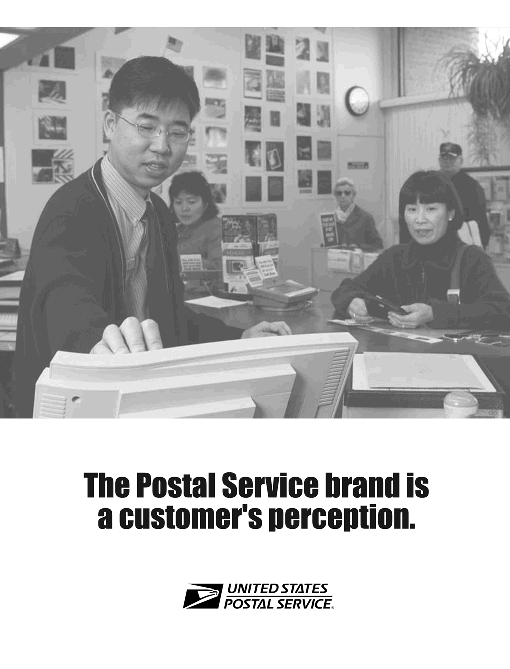
Management Instructions
Posters
Revised DirectivesHandbooks
Manuals
Notices
Publications
Revised Forms
Obsolete DirectivesHandbooks
Management Instructions
Posters
Obsolete Forms
- Policies and Procedures Information, Public Affairs and Communications, 9-5-02 ANNOUNCEMENT/REMINDER Biweekly E-mail Message Announcing Online Postal Bulletin - Beginning September 5, 2002Beginning September 5, 2002, we will send an e-mail message every 2 weeks to all employees who have an e- mail account, announcing that the current issue of the Postal Bulletin is available online. Important note: This does not affect distribution of printed copies to the Field. Field organizations will continue to receive printed copies of the Postal Bulletin. - Policies and Procedures
Information, PORTFOLIO MANAGERS, APPLICATION DEVELOPERS, AND BUSINESS MANAGERS RESPONSIBLE FOR GOLD TAPE APPLICATIONS Gold Tape RetirementThe Postal Service computing environment must move to a new, more efficient computing architecture as quickly as possible to realize the benefits of current technology. Therefore, effective immediately: The vice president, Information Technology, must ensure that application developers do not write new Gold Tape Novell/Windows 95 applications. Application developers and portfolio managers must ensure that new applications (1) are browser- accessible, browser-independent, and server-based and (2) use the Advanced Computing Environment (ACE) active directory for user authentication and authorization. Information Technology will retire the Gold Tape infrastructure in fiscal year 2003 and move all current Gold Tape-based applications to other platforms no later than the end of calendar year 2002. No upgrades to the Gold Tape infrastructure will be made after the end of fiscal year 2002. Except for changes approved by the vice president, Information Technology, only emergency security changes will be made. To facilitate the transition, business managers responsible for Gold Tape applications must do at least one of the following: - Ensure that these applications are rewritten as Web-based applications whenever possible. - Use terminal servers to centralize Gold Tape applications until they are rewritten as Web-based applications or retired, either of which must take place by the end of fiscal year 2006 (when the terminal server infrastructure will be deactivated). - In the few cases where a terminal server is not a viable interim option, cover the additional cost to have IT support the applications on the desktop. BackgroundPostal Service business applications have significantly improved productivity, but we must continue to enhance productivity even further. To this end, the Postal Service has begun moving from a client-server environment to one that is Web-based. By building Web-based applications, the Postal Service will take a major step toward providing information in a universally accessible format. Web-based applications provide information to any properly authenticated and authorized individual, company, or business partner as long as they use an industry-leading browser. Web-based applications can also significantly reduce support costs for individual desktop computers. At the same time, the Postal Service is implementing a new computing architecture and new technologies that, together, upgrade the aging Postal Service computing infrastructure and reduce the cost of the computing environment. The new computing infrastructure - the ACE - includes the following enhancements: A simplified desktop environment that provides greater manageability and reduced local administration. Execution of national applications from a centralized, server-centric model, which reduces the time, complexity, and cost associated with desktop execution. Web-based application designs that support a centralized execution model. A Postal Service-wide directory service with which to manage users and resources. The current Postal Service infrastructure consists of multiple architectures, systems, directories, and software. These multiple environments and systems are more expensive to maintain and require a detailed and time- consuming test and deployment cycle to protect the integrity of the infrastructure. The benefits of the ACE system cannot be fully realized until we retire the existing complex distributed computer architecture. We are incorporating the policy in this article into a management instruction (MI) about application development and Gold Tape retirement; look for an announcement in a future issue of the Postal Bulletin about avail- ability of the MI on the Postal Service PolicyNet Web site at http://blue.usps.gov/cpim; click on MIs. - Distributed Computing
Environment,
|
||||||||||||||||||||||||||||||||||||||||||||||||||||||||||||||||||||||||||||||||||||||||||||||||||||||||||||||||||||||||||||||||||||||||||||||||||||||||||||||||||||||||||||||||||||||||||||||||||||||||||||||||||||||||||||||||||||||||||||||||||||||||||||||||||||||||||||||||||||||||||||||||||||||||||||||||||||||||||||||||||||||||||||||||||||||||||||||||||||||||||||||||||||||||||||||||||||||||||||||||||||||||||||||||||||||||||||||||||||||||||||||||||||||||||||||||||||||||||||||||||||||||||||||||||||||||||||||||||||||||||||||||||||||||||||||||||||||||||||||||||||||||||||||||||||||||||
| Title of Mailing | Class
and Type of Mail |
Requested
Delivery Dates |
Number of Pieces (Millions) | Distribution | Presort Level | Comments |
|---|---|---|---|---|---|---|
| JCP Real You - All Sizes | Standard/ Catolog |
09/20-09/23 | 5 | Nationwide | Car-Rt | Quebecorworld |
| Halloween Postcard | Standard/ 3rd Class |
09/23-10/10 | 6 | Nationwide | Car-Rt, 3/5 | Webcraft, Chalfont, PA |
| - Business
Service Network Integration, Service and Market Development, 9-5-02 | ||||||
The Postal Service will be testing a proposed new postcard enhancement during the next fiscal year called the USPS MicroPaymentฎ service. The USPS MicroPayment service is a payment system for goods and services in the $1-10 range using First-Class Mailฎ postage stamps as currency. Postage stamps will serve as currency-in-kind for inexpensive purchases such as low-cost product offerings, trial subscriptions, music and software samples, nonprofit contributions, and service payments. The USPS MicroPayment service introduces a new option to companies looking to offer a method for purchasing low-price items where in the past, consumers could pay only by check, cash, or credit card.
Advertisers can distribute their cards in various ways such as through direct mail, in packages, in magazines, in catalogs, and as handouts. The USPS MicroPayment campaigns will generate revenue for advertisers to cover the cost of their advertising and fulfillment programs. Advertisers will also be able to use the fulfillment information to build a database for future direct-marketing programs. The Postal Service will generate revenue through a processing fee (currently 10% of payment postage), increased mail volume, potential fulfillment (package) volume, and future direct-mail volume. There is no permit, accounting, or annual fee associated with the program at this time.
The newly automated system will electronically deliver an image of the USPS MicroPayment card for the advertiser to use in fulfillment. The system also automatically delivers an accounting of the payment postage for each advertiser. Advertisers will receive the revenue from the program, less the postal processing fee, biweekly. The value of the program will continue to increase, for the Postal Service and the advertisers, as the redemption process is increasingly automated through Image Lift technology. In the future, images will be converted into data and will be transmitted to the advertisers. Also in the future, the redemption of the payment postage, less a processing fee, will be delivered electronically.
The advertiser will design the USPS MicroPayment mailpiece using specific parameters that we provide to them. The front of the card contains a facing identification mark (FIM), PLANET CodeTM, and POSTNET code, as well as a defined return address area. All cards will be centrally processed and contain the same POSTNET code. Correct placement of a FIM A is required for courtesy reply cards (CRC). As the program develops, we might allow business reply cards (BRC), and the type of card (BRC or CRC) will determine the FIM to be used. The PLANET Code will identify the advertiser and electronically sort the cards according to each advertiser's campaigns.
The opposite side will contain a payment postage area with defined stamp-affixing boxes for each stamp. Information or instructions about the USPS MicroPayment campaign may appear under the area where stamps will be placed. The current denomination of First-Class Mail stamps will be requested on the card as payment postage because they are most prevalent in the market and they maximize the ease-of-use for the program. Consumers may use other stamp denominations, but we will not allow meter strips at this time.
We have included a tear-out page illustrating design requirements at the end of this article along with a poster that you can use to inform all field employees about the USPS MicroPayment program and ongoing test.
Consumers will enter USPS MicroPayment cards into the mailstream by dropping the cards, with delivery postage affixed, in collection boxes or at Post Offices. The cards will all be addressed to a centralized processing facility. The payment postage will be affixed to the non-address side of the card; do not hand or machine cancel or deface the payment postage in any way. The centralized USPS MicroPayment processing facility will cancel or destroy the live payment postage after final processing and accounting occurs.
At the point of entry, the Advanced Facer Canceller System (AFCS) will automatically face the cards based on the FIM and then cancel the delivery postage. The cards will then be sent to a barcode sorter to be placed in trays for transport to the destination site as usual. The destination site will be the central processing facility where the program is being tested (site to be determined). The incoming mail will be placed on a barcode sorter at this site as usual but then it will be held out for internal processing in a secure section of the facility. Batches of cards will be placed in a feeder and sent through a scanner/Image Lift system for electronic processing. The payment postage will be automatically verified and accounted for. The image and an accounting of the payment postage will automatically be sent to the advertiser. After file transfer, and with advertiser approval, the cards will then be destroyed along with the uncancelled payment postage. As the system develops, the image will be converted into a data file for transmission to the advertiser as mentioned earlier.
Again, Image Lift "read rates" of the payment postage are adversely affected by cancellation. Therefore, do not hand cancel the payment postage during processing. Only the normal postmark cancellation of the delivery postage should occur (on the AFCS).
Advertisers will need to work with a Postal Service sales representative to apply to participate in the USPS MicroPayment test. To qualify for the test, advertisers must distribute a minimum of 10,000 cards; however, we are not setting a maximum at this time. Advertisers must fill out a registration form, permit application, and an agreement to participate to set up an account. Each form serves to increase communication between the advertiser and the Postal Service and to ensure the USPS MicroPayment test runs smoothly. The sales representative must send the forms to:
PROGRAM MANAGER
US POSTAL SERVICE
1735 N
LYNN ST RM 4013
ARLINGTON VA 22209-6331
The USPS MicroPayment test also depends on the Postal Service's ability to sort the cards and successfully recognize the scanned information on the cards. Therefore, advertisers must design and process the cards correctly. The PLANET Code must be readable so that the automation system is able to determine the correct advertiser, and the POSTNET barcode must be correct to ensure delivery to the central processing facility. As part of the USPS MicroPayment test, a mailpiece design analyst (MDA) will approve each mailpiece design before an advertiser may print or distribute it. A signed design approval form must be sent by the MDA to the program manager before the advertiser begins printing. After printing, a minimum of ten (10) samples of the card must be sent to the program manager so that the automation system can be programmed to accept the specific design.
We have included samples of USPS MicroPayment artwork at the end of this article. We created these samples to illustrate a potential design for cards; however, please note that the samples are not from actual advertisers.
Please use the tear-out poster "Now Testing USPS MicroPayment Service" on page 9 to inform customers and Postal Service employees about the USPS MicroPayment program and the ongoing test.
Tracker contains sales support information about the USPS MicroPayment service. The separate fact sheet, brochure, and success story are good leave-behinds. The kit with the CD ROM presentation can also be used with customers. We are in the process of updating the sales support material to include the automated redemption process and will make it available as soon as possible. We have included the Tracker item numbers for your convenience.
| Item | Item Number |
|---|---|
| Fact Sheet | 01MCPSSP008 |
| Brochure | 01MCPBRO009 |
| Success Story | 01MCPSSP010 |
| Kit with CD-ROM | 01MCPFOL001 |
Customer Connection will also have support information about the USPS MicroPayment service available to download when updated sales support material is ready for release.
If you have questions about the program or the test, call the USPS MicroPayment hotline at 866-617-7706, and a program specialist will respond.
Now Testing USPS MicroPayment Service
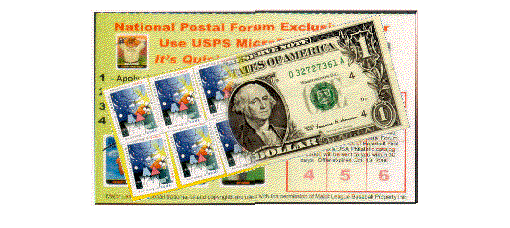
Program Description
The Postal Service will be testing a proposed enhancement of First-Class Mail service called the USPS MicroPayment service. The USPS MicroPayment service enables advertisers to collect postage as payment for offers in the $1-10 range. The Postal Service then redeems the postage, less a processing fee, and provides the advertiser with fulfillment information from the cards.
Card Description
The cards will be courtesy reply cards (although we might allow business reply cards in the future). The front of the mailpiece will contain a FIM, PLANET CodeTM and POSTNET code. The opposite side will include a payment postage area for affixing stamps as payment for goods, services, or donations. (See Design Requirements on page 10.)
Card Handling
Please process and deliver the USPS MicroPayment cards as First-Class Mail items without any special handling. Please do not cancel the payment postage. Canceling this postage will interfere with the automated processing of the cards for accounting purposes. These are legitimate test mailpieces for the USPS MicroPayment program and should be processed to the delivery address without any delays.
Information
If you have questions about the program or the test, call the USPS MicroPayment hotline at 866-617-7706, and a program specialist will respond.

(Cards are not to scale.)
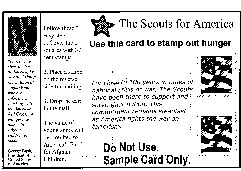
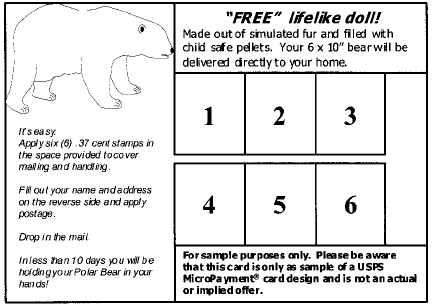
- Product Management - Letters,
Product
Development, 9-5-02
DMM TRANSFORMATION
It's here! A Domestic Mail Manual that is easy to use and understand.
We are launching the first stage of a multi-part project to redesign the Domestic Mail Manual (DMM). The new DMM is based on the ways that customers use the mail and focuses on the key decisions customers make in doing business with us.
The new DMM will look a lot different than it does now. We're breaking it into a series of smaller manuals and adding charts, illustrations, tips, and real-life examples to help customers understand our products and services.

The new DMM is divided into different pieces for different kinds of customers:
DMM 100 for retail customers (A Customer's Guide to Mailing; available now).
DMM 200 for beginning and small bulk mailers, small businesses, and nonprofit organizations.
DMM 300 for professional mailers.
DMM 400 for labeling lists, hazardous materials, and other special information.
The current DMM is the legal document that is the basis of our domestic mailing standards. The complexity of DMM Issue 57 can be frustrating for both employees and customers, and it discourages some potential customers from using the Postal Service.
In writing and publishing mailing standards, we have emphasized compliance with the law, the engineering requirements of our equipment, and the operational flow of mail through our system. While these are important objectives, there has been no comparable attempt to present mailing standards in a way that's easy for customers and employees to follow.
The information in the DMM is complicated, in that we offer many mailing alternatives to many kinds of customers. The new DMM series clarifies these alternatives for different employee and customer groups (e.g., retail customers, nonprofit organizations, small businesses, Postal Service administrators). The series structures information in new ways by clarifying options, using commonsense language, and applying a variety of navigational devices. We believe that this new approach to the DMM will:
Increase revenue. When customers understand our products and see that it is easy to do business with the Postal Service, they will use our services, not our competitors'.
Increase customer confidence and satisfaction in their choice of mailing services.
Empower customers to make decisions about mailing without needing to consult an expert.
Make it easier to increase sales by providing consistent, clear information that employees can use to explain Postal Service products and services to retail and business customers.
We are launching the first in the series, DMM 100, A Customer's Guide to Mailing, this month. We've reproduced pages from DMM 100 on the following pages to highlight some of the features of the document. Distribution information follows on page 17.
A Customer's Guide to Mailing: Key Features
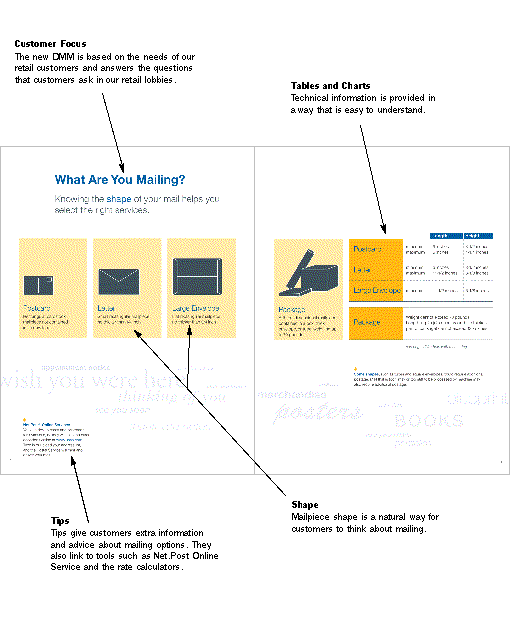
A Customer's Guide to Mailing: Key Features
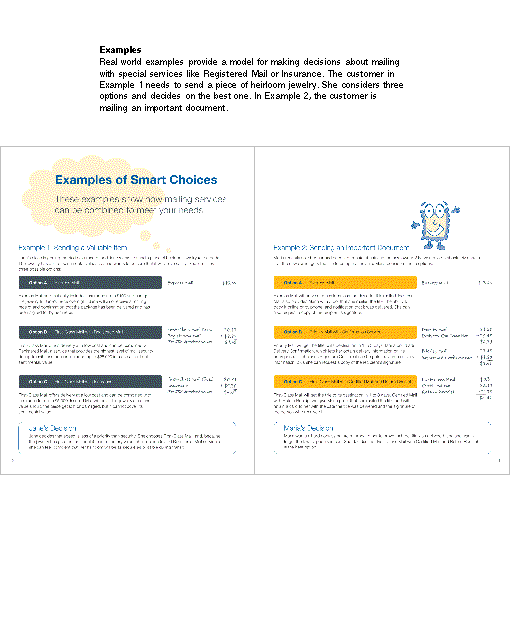
A Customer's Guide to Mailing: Key Features
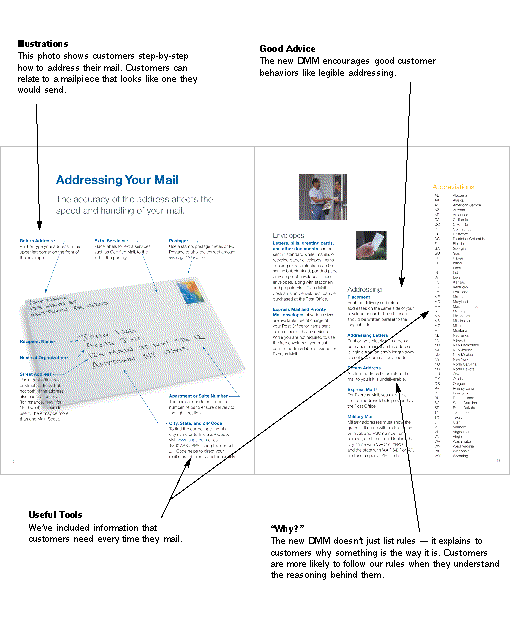
A Customer's Guide to Mailing: Key Features

DMM 100, A Customer's Guide to Mailing, carries the same weight and authority as the DMM that you know today. DMM 100 can answer most of the questions asked by retail customers. For more complex issues, such as questions about hazardous materials or free matter for the blind, you should continue to use the current DMM Issue 57.
DMM 100 for retail mailing is ready now. DMM 200, 300, and 400 will be published in stages. In the meantime, DMM Issue 57 and the new DMM 100 are your authorities for mailing standards.
Advance copies of DMM 100 have been mailed to each Post Office for distribution to employees, along with a standup talk. Employees should become familiar with DMM 100 and recognize it as a great way for customers to get information about Postal Service products and services.
In late September, each Post Office will receive a bulk quantity of DMM 100, along with a cardboard holder, for display in retail lobbies. Please encourage customers to take a free copy. Each rural carrier will receive five copies for customers on their route.
DMM 100 will be available soon to view and download from www.usps.com. Beginning in early October we will enclose a copy of the document with every order from the Postal Store on www.usps.com.
Facilities that need additional copies of the document can order them through the Material Distribution Center once they are stocked. We will provide ordering information in a future issue of the Postal Bulletin. Do not order them yet.
We hope that you find the new DMM easier to use. Be sure to fill out the comment card located on the back cover of DMM 100. You are a customer of the DMM, too, and we are counting on your feedback. Your comments will shape the rest of the DMM transformation and help us improve future versions of A Customer's Guide to Mailing.
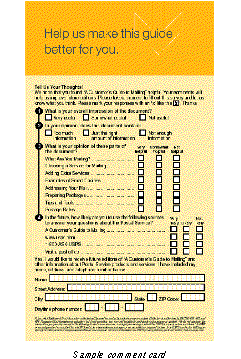
- Mail Preparation and
Standards,
Pricing and Classification, 9-5-02
Effective September 5, 2002, Domestic Mail Manual (DMM) L001, L004 and L606 are revised to reflect changes in mail processing operations. Mailers are encouraged to label according to these revised lists immediately, but must comply with these changes no later than November 17, 2002.
We will incorporate these revisions into the printed version of DMM Issue 58 and into the monthly update of the online DMM available via Postal Explorer at http://pe.usps.gov.
Domestic Mail Manual (DMM)
* * * * *
L Labeling Lists
L001 5-Digit Scheme - Periodicals Flats and Irregular Parcels, Standard Mail Flats, and BPM Flats
* * * * *
| Column
A Destination ZIP Codes |
Column
B Label Container To |
|---|---|
| Change From: | blank |
| 31701, 05 | ALBANY GA 31701 |
| 31709, 68, 92, 94 | AMERICUS GA 31709 |
| Change To: | blank |
| 31701, 05, 07 | ALBANY GA 31701 |
| 31709, 19 | AMERICUS GA 31709 |
| Add: | blank |
| 31757, 92 | THOMASVILLE GA 31757 |
| 31768, 88 | MOULTRIE GA 31768 |
| 31793, 94 | TIFTON GA 31794 |
| 39817, 19 | BAINBRIDGE GA 39817 |
| 39827, 28 | CAIRO GA 39827 |
* * * * *
L004 3-Digit ZIP Code Prefix Groups - ADC Sortation
* * * * *
| Column A 3-Digit ZIP Code Prefix Group |
Column
B Label to |
|---|---|
| Change From: | blank |
| 030-034, 038, 039 | ADC MANCHESTER NH 030 |
| Change To: | blank |
| 030-034, 038, 039 | (FCM and PER only)ADC MANCHESTER NH 030 |
| Add: | blank |
| 030-034, 038, 039 | (STD and BPM only)ADC PORTSMOUTH NH 038 |
* * * * *
L600 Standard Mail and Package Services
* * * * *
L606 5-Digit Scheme - Standard Mail and Package Services Parcels
* * * * *
| Column
A Destination ZIP Codes |
Column
B Label Container To |
|---|---|
| Change From: | blank |
| 31701, 04-07 | ALBANY GA 31701 |
| 31709, 10 | AMERICUS GA 31709 |
| 31757, 58 | THOMASVILLE GA 31757 |
| 31768, 76 | MOULTRIE GA 31768 |
| Change To: | blank |
| 31701, 05, 07 | ALBANY GA 31701 |
| 31709, 19 | AMERICUS GA 31709 |
| 31757, 58, 92, 99 | THOMASVILLE GA 31757 |
| 31768, 76, 88 | MOULTRIE GA 31768 |
| Column
A Destination ZIP Codes |
Column
B Label Container To |
|---|---|
| Add: | blank |
| 31702-04, 06, 08 | ALBANY GA 31702 |
| 39817, 18, 19 | BAINBRIDGE GA 39817 |
| 39827, 28 | CAIRO GA 39827 |
| Delete: | blank |
| 31717, 18 | BAINBRIDGE GA 31717 |
| 31792, 99 | THOMASVILLE GA 31792 |
* * * * *
- Logistics, Network Operations Management, 9-5-02
DMM REVISION
Effective September 5, 2002, Domestic Mail Manual (DMM) C820.4.1 is revised to clarify the wrapping instructions for AFSM 100 polywrapped automation flats.
Processing mail on the AFSM 100 provides savings opportunities. One of the Postal Service's objectives is to reduce processing costs by moving flat mail processing from the labor-intensive manual/mechanized environment to the more efficient automated mode. The additional machine capacity provided by AFSM 100 deployment enables a reduction in the overall amount of mail processed in manual/mechanized operations.
We designed the AFSM 100 preliminary test with specific analytical objectives to establish the physical criteria and other preparation requirements for automation flat eligibility. The test data for polywrapped pieces led us to conclude that the seam placement must be parallel to the length of the mailpiece. The placement of the seam on the addressed side versus the nonaddressed side did not result in significant performance differences. We will revise the wrap instructions contained in DMM Exhibit C820.4.1b (1) for the seam placement on polywrapped AFSM 100 mailpieces. There are no instructions on seam placement for the FSM 1000, other than to ensure the seam placement does not interfere with the address and barcode readability.
We will incorporate these revisions into the printed version of DMM Issue 58 and into the monthly update of the online DMM available via Postal Explorer at http://pe.usps.gov. We will also revise Quick Service Guide (QSG) 820 to include these changes.
Domestic Mail Manual (DMM)
* * * * *
C Characteristics and Content
* * * * *
C800 Automation-Compatible and Machinable Mail
* * * * *
C820 Flats
* * * * *
4.0 POLYWRAP COVERINGS
* * * * *
Exhibit 4.1b Wrap Instructions
[Revise item 1 to read as follows:]
1. a. For an AFSM 100 mailpiece, the wrap direction is the direction around the longer axis of the mailpiece. The seam must be parallel to the longest dimension.
b. For both an AFSM 100 and an FSM 1000 mailpiece, the preferred seam placement is on the non- addressed side of the mailpiece. If the seam is placed on the addressed side of the mailpiece, the seam must not cover any part of the address and barcode areas. The polywrap over the address area must be a smooth surface to avoid interference with address and barcode readability.
* * * * *
- Mail Preparation and
Standards,
Pricing and Classification, 9-5-02
